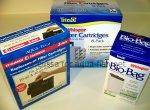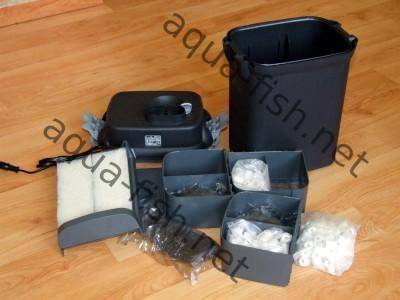Aquarium Filter Cartridges - Types, Purpose and Average Lifespan of Filter Cartridges
Every lover of keeping fish in an aquarium will know that proper filtration is one of the principal keys to success and enjoyment. Anything less than 100% efficient filtration will lead to unclear and foul smelling water, and will be detrimental to health of the fish in the tank as well as being generally unpleasant for all those in the general vicinity of the aquarium.For this reason any self respecting aquarium owner, either in a domestic or commercial application, should spend the time and the money to ensure that they have the best of filtration equipment available.
The smaller and less sophisticated aquariums used a fairly primitive form of water filtration that was housed in a small container that was hung in the corner of the tank. This was the first and at one time the only form of filtration available for aquariums and is still in use today for smaller aquariums. Basically inexpensive and simple to install, the “corner filter” was basically a plastic container filled with a basic form of filtration medium which could be either foam or floss. The water was forced through this far from state of the art filter by use of an arm pump, and the levels of filtration were far from perfect. A rare plus factor in describing a corner filter is that it also acts as an aerator, but on the other hand the air pump can be very noisy and disturbing especially if the tank is placed in a public area. Canister filters, on the other hand, are both pleasing to the eye as well as being noiseless.
These days, most medium to large size aquariums have a canister form of filter, which are generally fitted below the tank. The principal of filtering water before it enters the fish tank is the same as used when filtering water for drinking, agriculture or just about every other application where water should be filtered. The number of canisters can vary, according to localized levels of water quality or the quantity of water to be passed through the tank. Once the number of canisters to be installed has been ascertained then the type of filter to be inserted will also be decided.
Inside each canister is a series of filter cartridges, designed to perform three highly important functions required to maintain an aquatic environment which is both viable and healthy for the tank’s occupants.
These are as follows
- Mechanical filtration where either a filter pad, floss of a foam sleeve is used to roughly screen loose particles of debris or other forms of rough solid waste.
- Chemical filtration will use a form of media such as activated carbon for an example to remove pollutants in the water that are liable to cause unpleasant odors or discoloration in the water.
- Biological filtration is used to allow the flow of singular bacteria to that will eliminate any forms of toxic ammonia and nitrites.
Many aquarium operators and owners, especially the more inexperienced, are inclined to place too much trust in the filter cartridges once they have been installed. These filters, whilst they are highly effective, need to be maintained on a regular weekly basis, as well as having to be replaced from time to time. Each cartridge has its own life span, and every one of the cartridge manufacturers will generally give fairly objective advice as to how long you can stretch the cartridge’s life span. However an experienced aquariumist will have built up a form of sixth sense as to when the cartridge will need to be replaced. This fact is usually gauged by the sound of filter motor laboring through the filter being already clogged, the smell and the texture of the water in the tank and the state of the filter cartridges themselves. There is nothing more potentially damaging to the fish in the aquarium that unclean water and all steps should be taken to ensure that this calamity does not occur.
The average life span of an aquarium filter cartridge is around four weeks. However this target can only be achieved if regular weekly filter maintenance is carried out. Regular cleaning is a must, yet care and attention needs to be made to make sure that the any helpful bacteria on the cartridges are not washed away during the cleaning process. The costs of filter cartridges are not that high, and it is a very worthwhile tip to always have two sets on standby for replacement.
The first reason is that to keep the helpful bacteria levels in the tank up to the optimum level at all times is to clean one half of the filters alternately every three days in water that has been released from the tank and not tap water. At the same time you can replace the other half with clean filters that have been rinsed in tap water. If you rinse all of your filters in tap water, then the chlorine contained in the tap water will kill the bacteria. This method of alternating will allow for the retention of a fair percentage of the bacteria that will form new colonies in the new filter media.
Cleaning the cartridge filters should be a fairly straightforward operation, yet highly important to the continuity of life within the aquarium. Maintenance cleaning may sound a trifle oppressive yet it involves just washing down the filters with the water to be discarded. It is very important to remember that the filters should never be cleaned using either detergents or hot water as this will not only kill of all the friendly bacteria but will also shorten the filter’s life effective span of use.
Such is the importance of maintaining a regular schedule of filter cleaning maintenance to preserve the health and well being of your fish, that it should almost be compulsory to have at least two sets of spares in stock.
Articles related to filters on Aqua-Fish.Net
- The Purpose Of An Aquarium Filter
- Internal and External Aquarium Filters
- Tetra Whisper Filter
- Aquarium Filter Media
- Canister Filter in an Aquarium
- To Filter or not to Filter a Fish
- Fish Pond Filters
- External Filter for a 26 Gallon or Bigger Aquarium
- Undergravel Filters
- Aquarium Filer Pads
- About Fish Pond Filters
- Magnum and Penguin Aquarium Filter
- Aquarium Filter Systems
- Under Gravel filter Cleaning
- Diatom Filters for Aquariums

